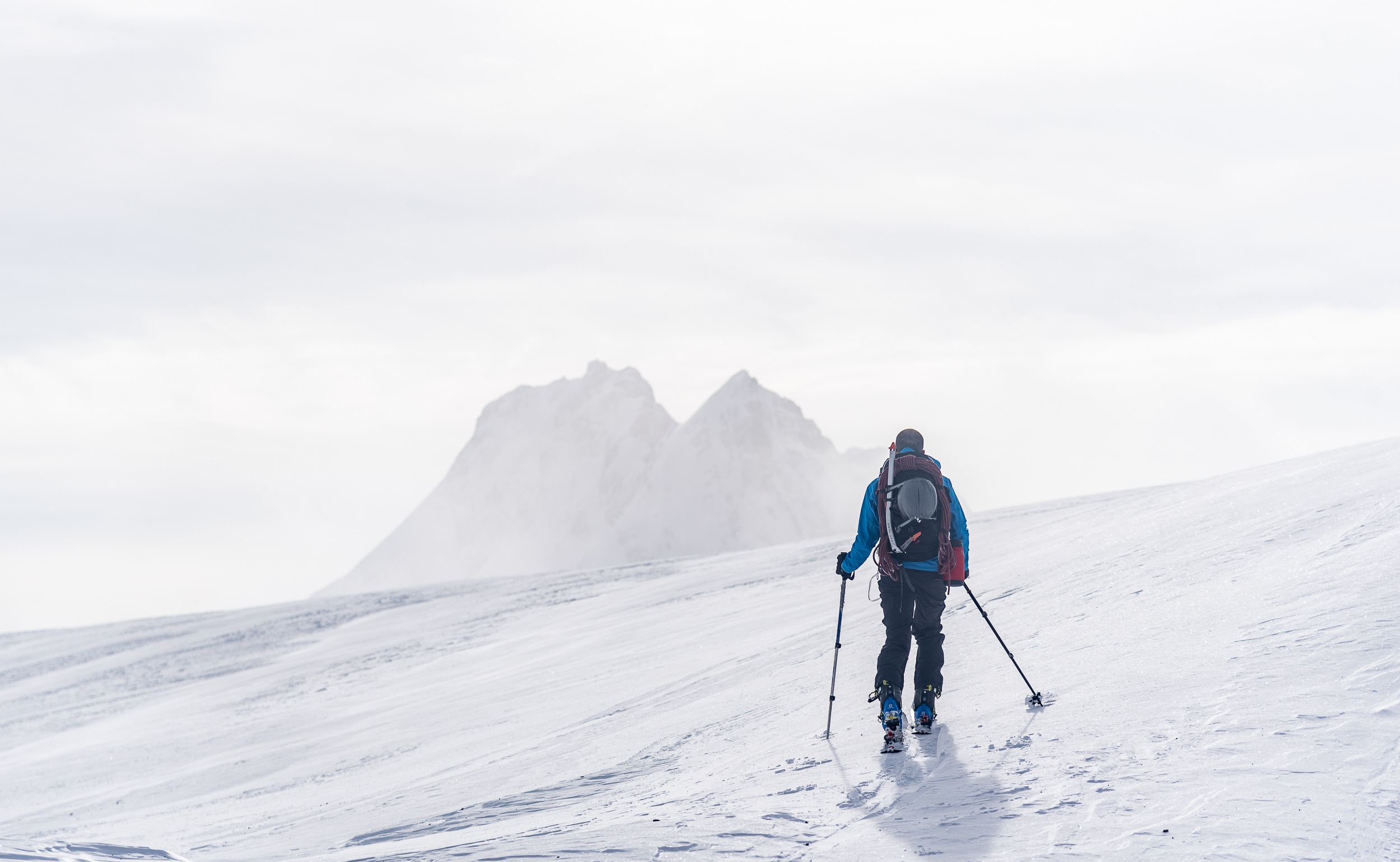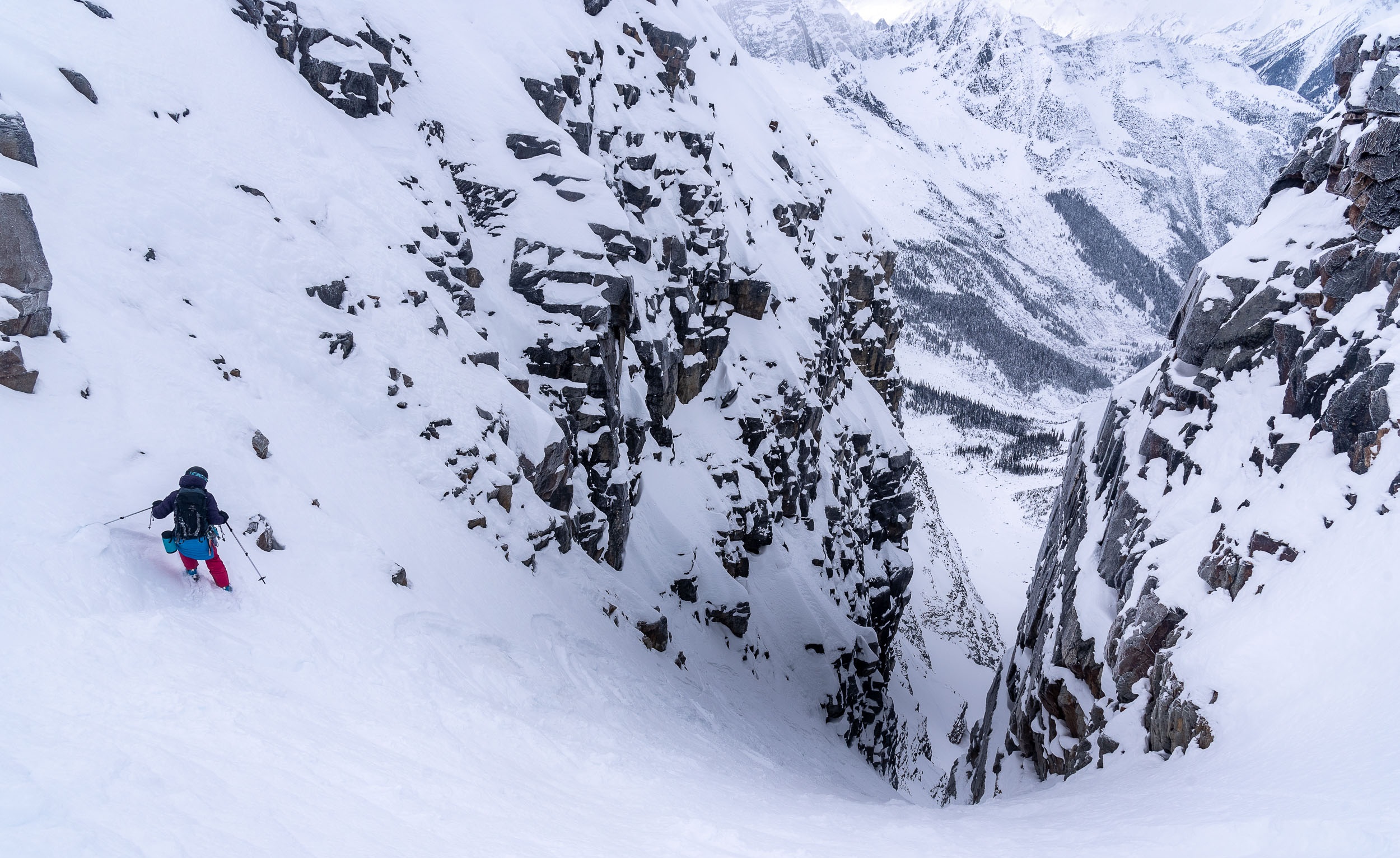Plan B: The French-Haig-Robertson Traverse

I’d heard from people for years that the French-Haig-Robertson Traverse was fantastic. Turns out those people weren’t lying, the FHR is gorgeous, fun, and in Calgary’s backyard.
I was supposed to go to the Tunnel Creek Hut in Fernie this weekend, but then Christine got sick and had to bail. I figured that as tempting as it would have been to ditch her and go without her, that I’d earn some boyfriend points and spend Saturday relaxing with her. And then I’d ditch her on Sunday and go skiing with David.
Skins on and getting ready to roll
We were looking for something that would be interesting and nearby and discussing options with Christine, she floated the French-Haig-Robertson Traverse. It had the added bonus that since she’d previously done it, it would reduce the FOMO she’d go through sitting at home.
The French-Haig-Robertson Traverse starts and ends at the Burstall Pass parking lot in Kananaskis. Chic Scott’s Summits and Icefields 1 calls the route 20km (I measured a bit more) and 1000m of elevation gain (I measured a bit less). The route connects the French, Haig, and Robertson glaciers and avoids any serious bushwhacking or trashing. All killer, no filler.
Reaching tree-line in the French Creek drainage
My usual math for this sort of fast travel terrain is 1 hour for every 4km or 400m of elevation gain. At 20km (5 hours) and 1000m of elevation (2.5 hours) I figured the route would take somewhere around 7.5 hours plus any breaks. I figured anything sub 8 hours would be pretty darn good, but we brought headlamps in case things were slower than expected.
Sunday, David and I hit the road a little after six and after driving the long way to the Burstall Pass parking lot through Canmore (so we could stop for coffee at the Rocky Mountain Bagel Company) we were geared up and ready to go at around 8:30am.
Approaching the French-Haig Pass
We quickly cruised up the French Creek drainage and hit the alpine by 11am. Quick travel continued and shortly after noon we cruised through the pass onto the Haig Glacier. As you come through the pass you go from being walled in to having a huge glacial vista erupt around you. It’s insanely beautiful. We decided it was a great place to stop for lunch. Before we did so though, we toured over to a safe spot near the bottom of the infamously steep slope that divides the Haig from the Robertson Glacier.
The infamous steep face separating the Haig Glacier from the Robertson Glacier
After a lazy lunch we got to the business of getting up the slope. There wasn’t enough snow to skin up and with it facing just about perfectly south, a pretty bulletproof crust had developed. We decided the safest bet would be to just bootpack straight up.
David puts his Whippet to good use. A slip would have sucked.
David led off kicking steps in. It was pretty efficient if tiring. It took a few good kicks to get a solid step, but there was no wallowing or excessive post holing. We’d both brought Black Diamond Whippets and I was pretty glad for them. Since getting mine I'm increasingly leaving my ice axe on my pack or at home altogether. They weren’t strictly necessary, but they increased our confidence when bootpacking up through the iciest portions of the face.
Looking out on the Haig Glacier
At the top of the steep slope we found ourselves looking down the length of the Robertson Glacier. All the snow that the wind scours off of the steep face we'd just climbed gets deposited onto the north facing Robertson Glacier so we spent a few moments sussing out the most conservative way onto the face. Ultimately we skinned a little ways up the east side of the pass to get around a cornice and then ripped skins and dropped in following a short ramp to avoid convexities.
David enjoying (generally) pleasant turns down the Robertson Glacier
The two most loaded words in skiing are ‘variable conditions’ and that’s what we had on the Robertson Glacier. Mostly the skiing was either shallow powder or crusty enough to support us on top - either are fine by me, but every once in a while we’d hit a patch of breakable crust and there’d be a frantic recovery as our weight got thrown forward by the sudden deceleration. Regardless, it was manageable and most of the skiing was great.
We avoided any of the obviously crevassed areas by skiing straight down the guts of things. I have no idea what the glacier looks like in the summer, but as we skied along there were no sags or other warning signs, so we felt pretty good.
Don’t ski into the bright blue holes
Eventually the glacier petered out, and if you look at the Gaia GPS track below, you can see that the last ~5km of basically dead flat slogging. Thanks to what is in the summer basically a big marsh, instead of slogging through the trees, you actually have great views of the mountains so you get to close out your day soaking in the surrounding peaks.
The skiing is mellow, but the views are great
We got back to the cars pretty much bang-on 7.5 hours after we beat our own expectations. We’d had broken trail almost the whole way, which allowed us to really move pretty quickly.
Other than the one steep face climbing up to the Robertson Glacier, there really isn’t much in the way of technical difficulties on the tour. There’s a bit of glacier travel, but we didn’t see much to worry about in regards to crevasses. The avi exposure felt very manageable to us, navigation was about as easy as it gets, and other than some icy side-hilling and bootpacking up to Robertson, the whole day felt super cruisey.
There’s some slogging at the bottom, but when you’ve views like that, it’s hard to argue
If it wasn’t for that steep face up to the Robertson Glacier, this would have felt like a great beginner ski tour. Unfortunately, that face (and then dropping into the glacier on the far side) complicates things pretty significantly. We bootpacked up and in the conditions we had a slip would have sucked pretty badly. Confidence bootpacking icy terrain was crucial. Later in the season when things are more filled in, that slope would have presented a really significant avi hazard. In the spring or during a chinook it’s due south aspect would make it seriously concerning. The result is that I think it’s a route to be approached cautiously.
5km of slogging on flat ground back to the car
Most of the time mid-winter is pretty much focused on going wherever the powder is deepest. This weekend I got thrown a curve ball when Christine got sick - but when your Plan B of exploring your back yard involves a route like the French-Haig-Robertson Traverse in absolutely perfect weather, well, it’s hard to get too upset about that.
Grumpy, cantankerous, wildly opinionated and so much more! Getting really tired on skis is what makes me happy.






